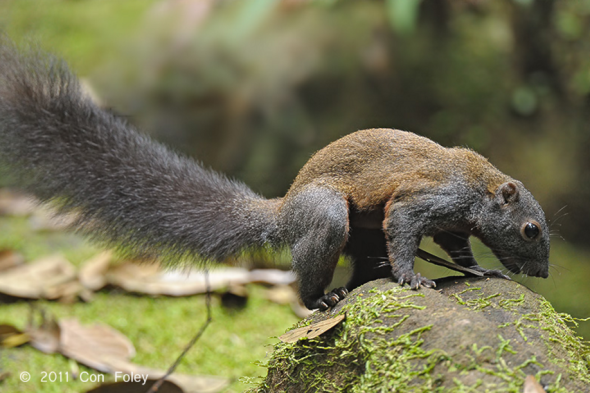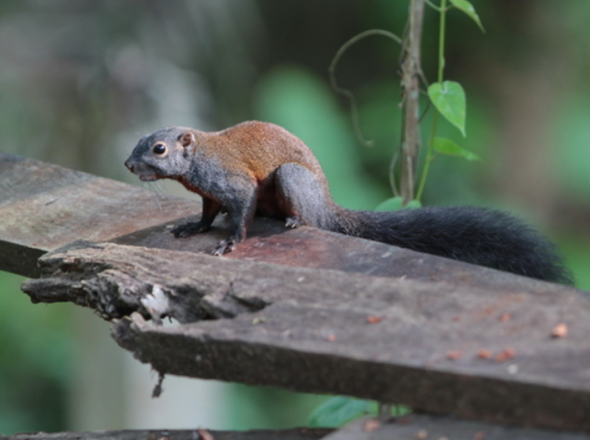ENDANGERED SPECIES MONDAY | SUNDASCIURUS HIPPURUS

ENDANGERED SPECIES MONDAY | SUNDASCIURUS HIPPURUS
This Mondays (E.S.P) post - [Endangered Species watch Post] I am documenting on the horse tailed squirrel, scientifically identified as Sundasciurus hippurus. (Image: Horse tailed squirrel. Credits: Con Foley)
Listed as [near threatened] the species was first discovered back in 1831 by French Dr Étienne Geoffroy Saint-Hilaire (15 April 1772 – 19 June 1844) who was a French naturalist who established the principle of “unity of composition”. He was a colleague of Jean-Baptiste Lamarck and expanded and defended Lamarck’s evolutionary theories.
Geoffroy’s scientific views had a transcendental flavor (unlike Lamarck’s materialistic views) and were similar to those of German morphologists like Lorenz Oken. He believed in the underlying unity of organismal design, and the possibility of the transmutation of species in time, amassing evidence for his claims through research in comparative anatomy, paleontology, and embryology.
Dr Geoffroy ‘allegedly’ named the squirrel ‘the horse tailed squirrel’ because the squirrels tail resembled that of a horse tail, although even I myself find that somewhat difficult to digest, as in all due honesty the tail looks more like a bushy tail, which horses don’t really host. Horses tend to have long, slender and non-bushy tails, while others do host a type of busy but lose tail. I could be wrong?!
While as yet I cannot prove this, I do believe that Dr Geoffroy may have named the squirrel after a wild dwarf Asiatic horse endemic to South East Asia - that as yet we environmentalists have as yet to discover more about, furthermore that species of horse is likely to be extinct.
Moving on and (as explained) the horse tailed squirrel has been listed as [near threatened]. From 1996-2012 the species was placed into the category of [lower risk/least concern]. Lower risk/least concern is defined as: A taxon is Least Concern when it has been evaluated against the criteria and does not qualify for Critically Endangered, Endangered, Vulnerable or Near Threatened. Widespread and abundant taxa are included in this category.
International Animal Rescue Foundation Asian Environmental Scientists have been studying this species (among others) and can confirm from camera traps that the mammal’s populations are still declining significantly. However to what extent we’re still unsure.
As yet there have been ‘no reported extinctions’ within anyone of the species endemic countries being: Brunei Darussalam; Indonesia (Kalimantan, Sumatera); Malaysia (Peninsular Malaysia, Sabah, Sarawak) and Thailand. Since 2012 environmental fauna scientists have tried in vain to establish a mean population count, unfortunately as yet we (the organisation) and non-related organisations cannot determine a true population count.
Back in 2004 Dr’s Han and Giman pers. comm stated that the species was common, furthermore there was no evidence to prove the species was severely fragmented, or nearing endangered. The species prefers to inhabits lowland forests, however is also located in secondary forests too. Scientists reported that within these secondary forests species populations were on the decline.
Unlike your normal European squirrel the species can commonly be located at ground level foraging for food ranging from nuts, fruits, seeds and insects. Interestingly the species is diurnal (again unlike the European squirrel). Diurnal means the species will be active either during the day or night. Whereas the European squirrel is normally pretty active during the daytime, then rests during the night.

Image: Horse tailed squirrel: Photographer unknown
While the species ‘often lives within the trees’, horse tailed squirrels will spend a majority of their time at ground level. It has been suggested that one of the reasons for low densities of this species in Malaysian tropical rain forest is competition from the great variety of other arboreal vertebrates (such as birds, and especially primates) for food, especially fruits and leaves, which are among the food items preferred by squirrels.
There are by few very few threats actually known, however don’t take that as positive news. The species is threatened by habitat loss due to logging and agricultural conversion. I expect the first extinctions are likely to be witnessed within Malaysia (based on past and current research). Malaysian deforestation and palm oil plantations all pose a very high threat to the horse tailed squirrel as well as many other species of flora and fauna.
Nearly 60% of Malaysia is still covered with natural rain forest, unfortunately much of Malaysia forests are devoted to cash crop plantations, particularly oil palm and rubber, with tree crops occupying 17% of Malaysia’s land area. These are ideally suited to Malaysia’s hot, wet, and humid climate.
While many of us are aware of ‘palm oil devastation’ which is probably by far the biggest threat to a wide number of animals and plants - including the horse tailed squirrel. I would also like to point out to many non-meat and dairy consumers (I.e: Vegans), that while coconut plantations are for now considerably small. These plantations are still being developed and farmed within areas that once saw pristine green forests - now nothing more than a brown churned up heap of land growing and harvesting coconuts too.
In Malaysia, coconut is the fourth important industrial crop after oil palm, rubber and paddy in terms of total planted area. It is also one of the oldest agro-based industries. As an industry, coconut contributes very little to the overall economy of Malaysia (contribution to export earnings of about 0.08% in 2006).
Recent competition with oil palm for land has also resulted in the decline of the total area under coconut cultivation: in 2001, the area was about 151,000 ha and this has gradually decreased to the acreage of 109,185 ha in 2007. Based on the estimates given under the 9th Malaysia Plan, it is anticipated that the acreage will consolidate to around 80,000 ha by 2010. However regardless of this ‘alleged decline’ most if not all coconut plantations are farmed within forests where species such as the horse tailed squirrel is inhabiting.
The species is found in several protected areas, including Pasoh Forest Reserve. Environmentalists state the need for further comparative study on this species’ abundance, density and distribution and its relationship to forest structure or habitat quality, spatially and temporally, in hill dipterocarp forest of Malaysia is greatly needed.
For now the future of the horse tailed squirrel is uncertain. I’m doubtful the species will remain extant within Malaysia for much longer - with possible localized extinctions witnessed here soon. More research needs to be undertaken on the species, furthermore we also need to research just how much ‘pristine green forest is being converted for fruit, cereal crops, oils and plant milk crops’ rather than just palm oil. While I find palm oil agriculture incredibly concerning. Knowing that anyone of our vegan, vegetable and fruit crops is originating from areas where animals are being killed - is just as concerning too.
Thank you for reading.
Dr Jose C. Depre PhD. MEnvSc. BSc(Hons) Botany, PhD(NeuroSci) D.V.M.
Master of Environmental Botanical & Human Science.
(Environmental, Botanical & Human Scientist).


